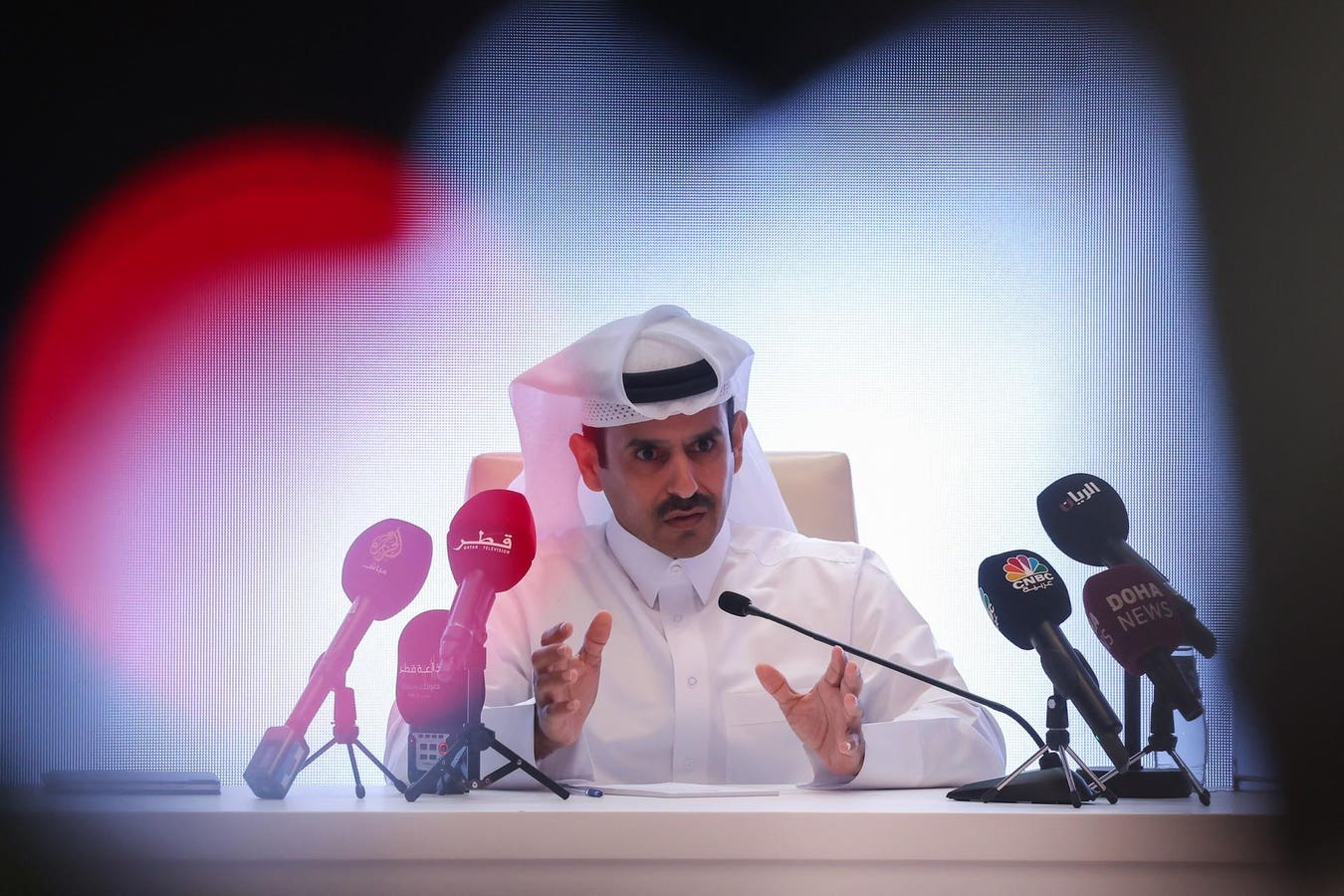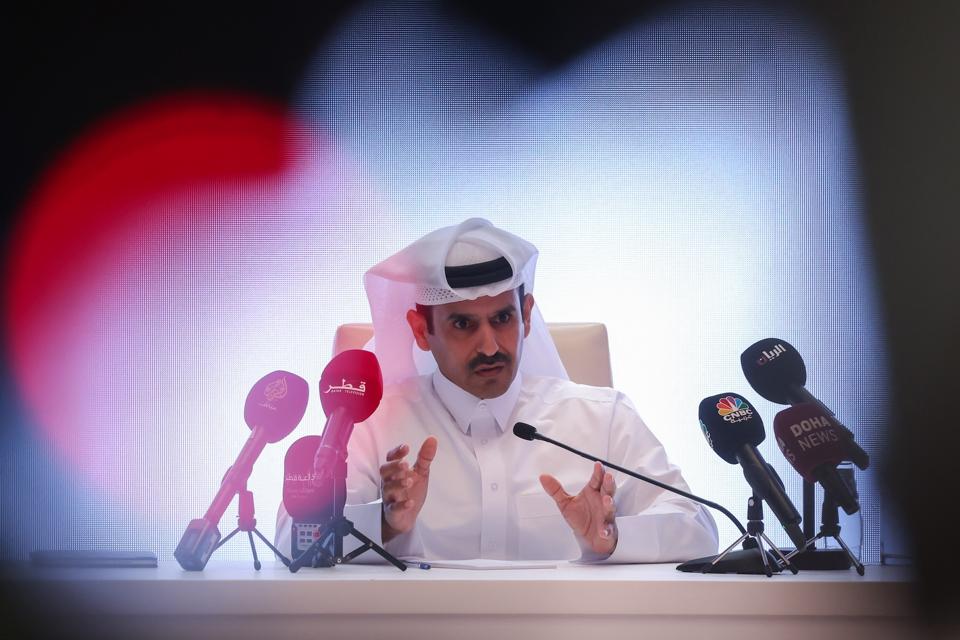Qatar’s Energy Minister and CEO of QatarEnergy Saad Sherida al-Kaabi speaks during a press … More conference in Doha on September 1, 2024. (Photo by KARIM JAAFAR / AFP) (Photo by KARIM JAAFAR/AFP via Getty Images)
AFP via Getty Images
Fresh alarm. In a 20 June Reuters exclusive, Doha confirmed that it hauled ExxonMobil, Shell and TotalEnergies into a closed-door meeting two days earlier, warning that one stray missile in the Strait of Hormuz could instantly wipe out one-fifth of global LNG supply. Asian spot prices obeyed the signal—jumping 11 percent to $14/mmBtu before London markets had fully digested the headline.
One narrow waterway still moves the world. Hormuz pinches to 21 nautical miles at its choke and carries roughly 20 million barrels of oil—about one-fifth of global seaborne supply—plus a similar share of LNG every day. Close the channel and power stations from Houston to Hong Kong scramble for fuel while tanker queues lengthen by thousands of nautical miles.
Three pressure points frame every forecast
Chokepoint concentration. The International Energy Agency calculates that only about 6.5 million barrels a day can shift quickly to Fujairah, SUMED or inventories; the balance simply waits.
Price-shock amplitude. Additional-war-risk premiums (AWRP) on very-large crude carriers have rocketed from 0.05 percent to 0.25 percent of hull value—roughly a US $225 000 surcharge on each $90 million ship—and forward Brent markets now build in triple-digit scenarios for any prolonged disruption.
Policy bandwidth. True spare capacity inside OPEC clocks in near three million barrels a day and sits inside the same blast zone, leaving diplomacy—so far untested in open conflict—to carry most of the burden.
Backup pipes replace only a sliver. Saudi Arabia’s East-West line and the UAE’s Habshan–Fujairah bypass together provide about 2.6 million barrels a day of spare capacity, barely one-eighth of normal Hormuz throughput. Even a coordinated drawdown of strategic storage could not keep two-thirds of Gulf exports moving if the strait closed for a week.
Insurance costs shout before oil charts whisper. Since 13 June, tanker underwriters have priced the region as an active war zone. A five-fold jump in AWRP lands before a single barrel is lifted, signalling risk faster than futures curves can. For a refiner, those premiums flow straight into delivered crude costs within days.
Freight rates leap in lock-step. Gulf-to-Asia VLCC rates hit $2.14 per barrel on 17 June—60 percent higher in just five days—and charterers now fix ships day-to-day rather than locking in multi-month contracts. The volatility premium migrates down the supply chain, raising break-even prices for refiners, airlines and petrochemicals alike.
Qatar’s tankers loiter outside the Gulf. QatarEnergy has instructed LNG carriers to remain east of Hormuz until the day before loading. AIS data confirm a multi-year low in Persian-Gulf-bound empty tankers—evidence of growing caution even as contractual volumes continue to flow.
Spare capacity sits where missiles can reach it. RBC Capital Markets pegs genuine OPEC spare capacity at roughly three million barrels per day, nearly all within Hormuz’s threat ring. Every new headline—whether a cease-fire whisper or another drone strike—moves Brent and insurance quotes long before drilling rigs or pipelines can respond.
Economic ripples extend well beyond crude. Higher tanker premiums bleed into LNG freight, lifting electricity costs that keep AI data centres humming. European refiners, already paying roughly €70 per tonne of CO₂, see margins flip negative once reroute costs stack up; Asian importers instead burn through stockpiles that last weeks, not months. Insurance leverage unseen since the late 1980s now shows up in airline ticket prices and industrial power bills.
Numbers translate geopolitics into P&L. U.S. energy-agency models suggest each $10 oil shock trims about one-tenth of a percentage point from U.S. GDP. BloombergNEF freight curves add another $1.60 per barrel for a Cape of Good Hope detour plus $0.80 in bunker fuel. War-risk elasticity studies show that 70 percent of an insurance premium embeds into headline freight within a fortnight—effectively turning geopolitical anxiety into everyday costs at the pump.
Strategic takeaway remains uncomplicated. Boards cannot micromanage every contingency, but they can widen risk limits, diversify shipping lanes and co-fund a GCC–EU “Hormuz Alternative Route Task-Force.” The planning bill is trivial next to today’s $225 000 voyage surcharge. In the absence of bold collective action, every forward-freight contract will continue to price a toll for geopolitical complacency. Better to pre-empt that charge than pay it in arrears.

